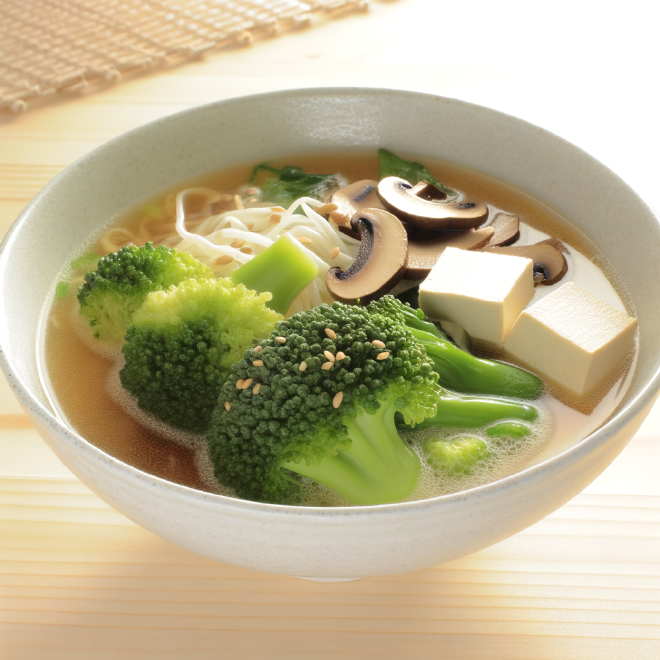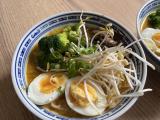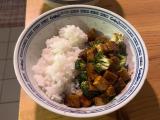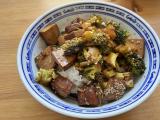Vegan Firecracker Ramen
Table of Contents
Jump to Recipe
Jump to Carbon Footprint

Recently, a vegetarian Firecracker Ramen recipe appeared here on the blog that uses egg, among other things. This recipe provides a vegan version of this by using silken tofu instead of egg.
What impact does this one small change have on the recipe’s carbon footprint? Let’s find out!
The ramen broth and the recipe are based on the “Firecracker Ramen” by “alfiecooks_”, which can be seen on TikTok or YouTube.
Recipe #
Vegan firecracker ramen, inspired by Alfie Cooks
60 minutes
2 portions
Ingredients #
For the broth #
- 2 cloves garlic
- about 10 g ginger
- 1/2 red chili pepper
- 1/2 bunch spring onions (keep the green for garnishing)
- 2 teaspoons oil
- 1/2 teaspoon turmeric
- 2-3 teaspoons of gochujang paste (Korean spice paste)
- 1 teaspoon rice vinegar
- 1 teaspoon soy sauce
- 750 ml mushroom stock (equivalent to 1.5 stock cubes)
- 100 ml coconut milk
- 1 teaspoon miso paste
- Juice of 1/2 lime
- 1 pinch of salt
- 1 pinch of pepper
For the toppings #
- about 150 g oyster mushrooms
- about 80 g broccoli
- about 120-140 g silken tofu
- 180 g ramen noodles
- 1 teaspoon roasted sesame seeds
- the greens from 1/2 bunch of spring onions (see above)
Directions #
- Peel and finely dice the garlic and ginger. Wash the chili pepper and spring onions and cut into small cubes.
- Heat 1 tablespoon of oil in a large pan over medium heat. Add the spring onions, chili, ginger, and garlic. Season with a pinch of salt and fry for a few minutes until fragrant. Add the gochujang paste, rice vinegar, soy sauce, and turmeric and stir well.
- Then add the stock in the same pan or mix the stock cubes with boiling water and stir well until the stock has dissolved. Add the coconut milk and miso paste and simmer for about 10-15 minutes. Season to taste with salt and pepper and the lime juice. Add a little sugar to balance the spiciness if necessary.
- While the stock is simmering, prepare the toppings: Wash and roughly chop the oyster mushrooms. Heat a little oil in a pan and fry the mushrooms, turning occasionally.
- Wash the broccoli and cut into florets. Heat a little oil in a pan and sauté the broccoli in it, then pour in a little water and steam the broccoli for about 4 minutes.
- Carefully remove the silken tofu from the packet and drain lightly on some kitchen paper. Carefully cut into cubes and set aside until ready to serve; then gently slide into the stock.
- Cook the ramen noodles according to the instructions on the packet. At the same time, toast some sesame seeds in a pan.
- To serve, place the noodles in two deep bowls. Pour over plenty of broth and serve with mushrooms, broccoli, spring onions, silken tofu, and sesame seeds. Optionally serve with chili oil.
Carbon Footprint #
In total, two portions of vegan Firecracker Ramen have an **estimated carbon footprint of 1108 g
This ranks it number 17 out of 57 recipes published on the blog so far in terms of estimated carbon footprint.
It is therefore part of the best tertile (top 33%) of the recipes with the lowest emission impact. 🤗Even if we only change one ingredient compared to the Wagamama Firecracker Ramen and replace the egg with silken tofu, the estimated carbon footprint is immediately reduced by 12% (1108 g instead of 1265 g).
Most of the ingredients are unremarkable, only the oyster mushrooms and silken tofu make a slightly above-average contribution to the overall good carbon footprint.
| ingredient | carbon footprint per kg | carbon footprint (in g) for 2 servings | % of ingredients | % of CO2 emissions |
|---|---|---|---|---|
| Garlic | 0.5 | 3 | 0% | 0% |
| Ginger | 0.5 | 5 | 1% | 0% |
| Chili | 1.1 | 5 | 0% | 0% |
| Spring onion | 0.7 | 56 | 5% | 5% |
| Oil | 3.3 | 53 | 1% | 5% |
| Turmeric | 1.1 | 2 | 0% | 0% |
| Gochujang paste | 0.2 | 6 | 2% | 0% |
| Rice vinegar | 1.4 | 14 | 1% | 1% |
| Soy sauce | 1.2 | 12 | 1% | 1% |
| Mushroom bouillon | 0.3 | 240 | 46% | 22% |
| Coconut milk | 0.5 | 52 | 6% | 5% |
| Miso paste | 0.2 | 3 | 1% | 0% |
| Lime | 0.6 | 47 | 5% | 4% |
| Salt | 0.7 | 1 | 0% | 0% |
| Pepper | 1.4 | 1 | 0% | 0% |
| Oyster mushrooms | 1.3 | 130 | 6% | 12% |
| Broccoli | 0.3 | 24 | 5% | 2% |
| Silken tofu | 1.0 | 150 | 9% | 14% |
| Ramen noodles | 0.7 | 126 | 11% | 11% |
| Sesame | 6.1 | 61 | 1% | 5% |
| Cooking broth | 83 | 8% | ||
| Fry mushrooms | 3 | 0% | ||
| Steaming broccoli | 7 | 1% | ||
| Cooking pasta | 26 | 2% |


